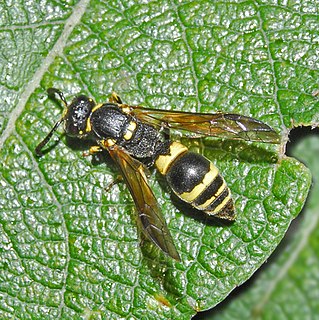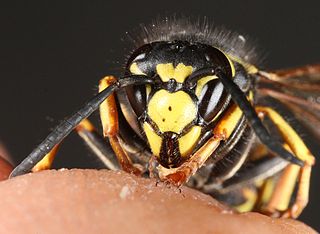
Paper wasps are a type of vespid wasps. The term is typically used to refer to members of the vespid subfamily Polistinae, though it often colloquially includes members of the subfamilies Vespinae and Stenogastrinae, which also make nests out of paper.

Potter wasps, the Eumeninae, are a cosmopolitan wasp group presently treated as a subfamily of Vespidae, but sometimes recognized in the past as a separate family, Eumenidae.

The Stenogastrinae are a subfamily of social wasps included in the family Vespidae. They are sometimes called hover wasps owing to the particular hovering flight of some species. Their morphology and biology present interesting peculiarities.

Delta is an Old World genus of potter wasps with species predominantly distributed through tropical Africa and Asia. Some species are present in the Palearctic region, and a few have been introduced in the Nearctic and Neotropical regions. The members of this genus have a long metasomal petiole, like members of the genera Eumenes and Zeta.

Symmorphus is a primarily holarctic genus of potter wasps.within the family Vespidae.
Paramischocyttarus is a small afrotropical and palearctic Zethus-like genus of potter wasps.

The Norwegian wasp is a species of eusocial wasp. It is common in Scandinavia and can also be found in Scotland and other areas in Britain and Ireland. Often known for being a tree wasp, it nests in low branches and bushes and feeds on insects. It also obtains nectar from blueberry and snowberry flowers. Although D. norwegica is rarely considered a pest in the past, a few cases of pest problems relating to them have been reported. The species is not endangered.

Dolichovespula adulterina is a species of parasitic social wasp found in the Palearctic region. D. adulterina feeds on a variety of foods, including insects, spiders, arthropods, meat, molluscs, fruit, nectar, and larval secretions. D. adulterina was formerly considered to be synonymous with D. arctica from the Holarctic region, but more recent research indicates that D. arctica is a separate species.

Vespula rufa, commonly known as the red wasp, is a social wasp species belonging to the genus Vespula. It is found in northern and central Europe and parts of Asia. Vespula rufa is characterised by red-brown markings and body segmentation, with the appearance varying amongst the different roles of individuals in the species. These wasps build small nests in dry banks underground that are not far below the surface. The colony cycle begins in the fall. Vespula rufa feed on live insects. One interesting fact about Vespula rufa is that the queen policing occurs in the species, and that worker policing occurs at much lower rates than other species in the genus Vespula. There are predators and parasites of the species. The species goes through a series of events before leaving the nest.

Vespula austriaca is an obligate parasitic wasp, parasitizing the nests of other species in the genus Vespula in the Old World. Its common host species include V. rufa in Europe, Japan, and East Siberia.V. austriaca wasps pollinate orchids.

Polistes carnifex, commonly known as the executioner wasp or executioner paper wasp, is a neotropical vespid wasp in the cosmopolitan genus Polistes.
Labochilus is a Palearctic genus of potter wasps. It contains the following species:
Paralionotulus is a monotypic Palearctic genus of potter wasps, the sole species being Paralionotulus mervensis which was originally described in 1887 by the Polish entomologist Oktawiusz Radoszkowski as Leptochilus mervensis.
Pseudoleptochilus is a small Palearctic genus of potter wasps consisting of two species.
Pseudosymmorphus is a small Palearctic genus of potter wasps from North Africa and the Middle East, containing four species.

Polistes carolina is one of two species of red paper wasp found in the eastern United States and is noted for the finer ridges on its propodeum. It is a social wasp in the family Vespidae and subfamily Polistinae. The species is native to the United States from Texas to Florida, north to New York, and west to Nebraska. The wasp's common name is due to the reddish-brown color of its head and body. P. carolina prefer to build their nests in protected spaces.

Dolichovespula arenaria, also known as the common aerial yellowjacket, sandhills hornet, and common yellow hornet, is a species of wasp within the genus Dolichovespula widely distributed in the North American continent.

Chrysis ignita is a species of cuckoo wasp. It is one of a group of species which are difficult to separate and which may be referred to as ruby-tailed wasps.

Symmorphus cristatus is a species of mason wasp in the subfamily Eumeninae within the family Vespidae. This species is widely distributed in North America, and it preys on the larvae of leaf beetles.













